Gallery: Behind-the-Scenes of HBO’s '100 Foot Wave'
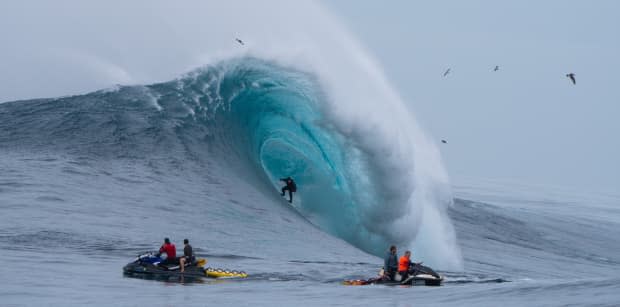
Photo: Pedro Bala/HBO
Surfing is not a mainstream sport.
When it comes to viewership, compared to football or basketball or soccer, surfing has struggled to break through to the masses, to resonate beyond hardcore surfers and into the larger, non-surfing demographic. Sure, there are exceptions – The Endless Summer (1964), Step Into Liquid (2003), Riding Giants (2004), etc. – but generally speaking, only surfers like to watch surfing.
Big screen, or small; in a competition jersey, or out; any way you slice it.
But one show, recently, has done the seemingly impossible. HBO’s 100 Foot Wave has appealed to both endemic and non-endemic audiences by chronicling an elite crew of big-wave surfers as they explore the boundaries of their sport worldwide, but mostly in Nazaré, Portugal, and search for that elusive, titular 10-story-tall wall of water.
With two seasons in the books, multiple Emmy nominations, two Emmy wins, and a new season approaching, 100 Foot Wave has to be one of the most successful pieces of surf media ever produced. But why is that? Is it because big waves represent a universal fear of death and drowning? Is it because the show is so beautifully shot and cut together? Probably a bit of both.
To find out more, we spoke to 100 Foot Wave’s Executive Producer Joe Lewis. And through his words – and the behind-the-scenes imagery below, some of which is currently on display at the Morrison Hotel Gallery – we got an inside look at the Emmy Award-winning show.
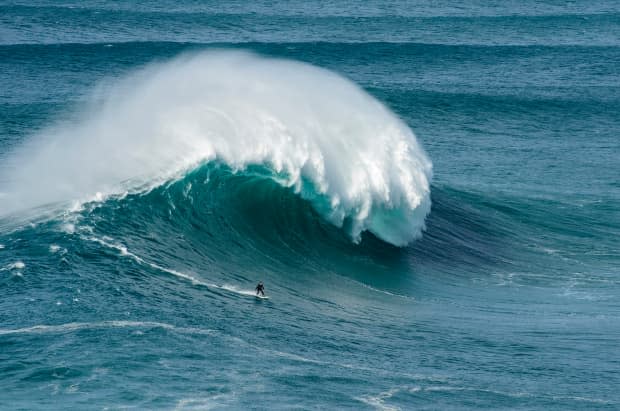
Photo: Helio Antonio/HBO
Hey Joe, how’s it going?
It’s going well. Busy. They had the contest at Nazaré today, so that’s always a pretty hectic day for us. But overall, good.
So, you’re a producer; you’ve got your own studio, Ampify Pictures; you’ve worked on a lot big-time, mainstream shows like Fleabag, Transparent, The Marvelous Mrs. Maisel, etc. How’d you end up working on 100 Foot Wave?
Throughout my career, I’ve worked in a lot of different areas. I started out in comedy. I was at Comedy Central. I was a studio executive at Fox. I tried to start my own TV network, which led me to be the first person at Amazon [Studios]. So, my background was primarily scripted comedy and drama. But I also did documentaries with Amazon – one was Long Strange Trip about the Grateful Dead, and the other was a show called The New Yorker Presents.
So, with 100 Foot Wave, something special happened. My wife’s second cousin is Nicole McNamara. She’s married to Garrett [McNamara] and is the second lead of the show. So, they had the idea of Garrett returning to Nazaré, inviting Cotty [Andrew Cotton] and Nicole’s brother CJ [Macias].
They asked me for some advice, and I was really intrigued. So, I said I would produce it. I brought it to Chris Smith, who is an incredible filmmaker. Two weeks later, we started shooting. And that was almost five years ago now.
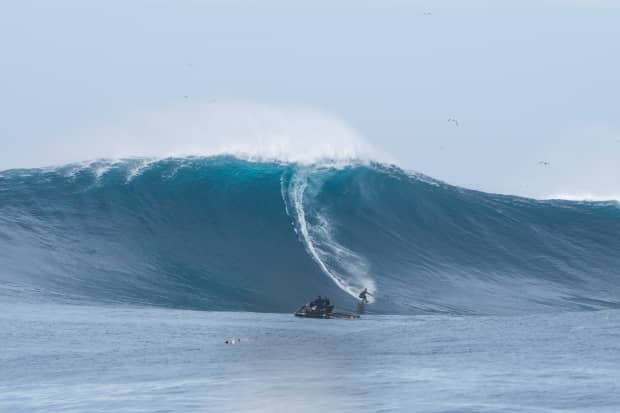
Photo: Pedro Bala/HBO
Are you a surfer yourself?
I was a minor surfer, but completely unaware of the greater surf world. Chris [Smith, the director] is not a surfer at all. I’m the world’s worst surfer who has been doing it for 20 years. [Laughs.] I’m fine once I’m on the wave, but I’m slow at getting into position and making it out to the lineup.
But I will say that working on the show has made be a better surfer. It’s like osmosis. By listening to Garrett and everyone else, and hearing them talk about conquering their fears and the nitty gritty of surfing, I’ve had less fear surfing four or five foot waves than I would’ve before.
"I have no doubt [the 100 foot wave] exists. And I have no doubt that it’s surfable. It’s just a question of: Can we be there when it happens?"
When you’re somewhere on location, like Nazaré, has G-Mac ever wanted to whip you into a wave?
Oh, yeah. And not just Garrett. Plenty of surfers have offered. I’ve been out on a jetski with Garrett on a choppy 30-to-40 foot day. Garrett likes to give you a good ride. We were sitting out there, and he was checking something on the sled, then suddenly a 40-footer came and we had to take off.
When you’re at these locations, and you’re spending time with these incredible surfers, you start to feel that you could do it. I’ve contemplated it. I think if I asked, and it wasn’t too crazy of a day, I think Garrett would do it.
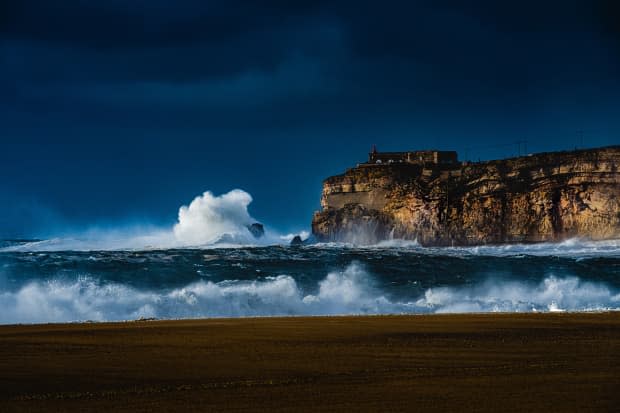
Photo: Pablo Garcia/HBO
100 Foot Wave has done something that not a lot of surf media can do, and something they’ve strived to do for decades – it’s resonated with a non-surfing audience. Why do you think that is?
Again, the director Chris and I are essentially non-surfers. We have to explain things. I think there’s something inherently broad and global and inspiring and visually appealing in big-wave surfing. As much as I can give us credit for keeping the story moving, the subject matter is just exciting and entertaining to watch.
And then there’s Garrett’s story. He just keeps trying, decades in, to do something that might not exist. There’s a universality to his story. And it just so happens to be something visually stunning. Now, there are other people in the big-wave world doing the same thing. You don’t have to be a surfer to be impressed by that.
The show definitely delves into the people, rather than just pure action, which is difficult for non-surfers to relate to. Do you think that’s part of its success?
We have a good amount of surfing in the show, but it’s not entirely about that. We’ve found that a little bit of surfing goes a long way. The show can’t survive with just wave after wave. I love watching big-wave surfing, but the people and their stories is what keeps it moving.
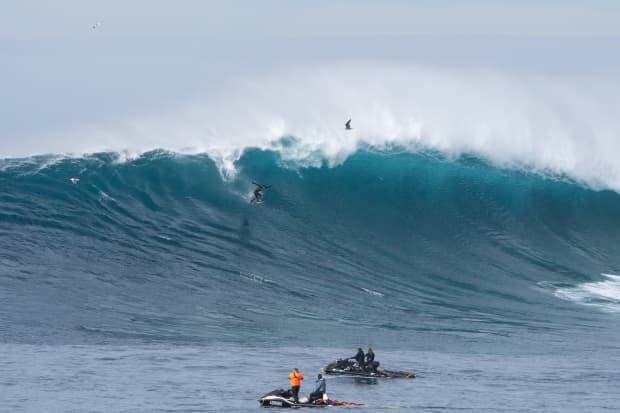
Photo: Pedro Bala/HBO
You guys won an Emmy. That must’ve been a pretty cool moment, and also validation that this show is a hit with the wider public.
We won Best Cinematography the first season, and we were nominated for Best Show. We lost to The Beatles [Get Back, 2021], which is understandable. We were nominated for six Emmys with season two, which was more than any other documentary series. To win Best Cinematography was amazing. Our camera team moved their lives to Nazaré for six months out of the year. It’s awesome to see people rewarded who are out there killing it every day.
"A little bit of surfing goes a long way. The show can’t survive with just wave after wave. I love watching big wave surfing, but the people and their stories is what keeps it moving."
So, season three is coming. What can we expect?
Every year the show has grown in scope, destinations, characters. We go to some new locations this year, like our amazing mission to Cortes Bank. Also Hawaii, Mavericks…a lot of Pacific. There’s been some really interesting stuff that’s happened in Nazaré. Still no 100 foot wave. But there was a world record [Sebastian Steudtner; Nazaré, Portugal; October, 2020; 86 feet].
Speaking of the world record, do you think a 100-foot wave exists? Do you think it’s surfable?
I have no doubt that it exists. And I have no doubt that it’s surfable. It’s just a question of: Can we be there when it happens? We don’t get into measuring waves on the show, and it’s a very hard thing to do. Maybe 100-foot waves have been ridden. I’m sure they’ve broken and nobody was there to surf them. I think it’ll happen at some point. More and more of these waves are being ridden, but so many things have to come together. Who knows, maybe it’ll be at Cortes and not Nazaré. And I’m sure there’s more waves out there waiting to be found and surfed.
What happens to the show if someone surfs a hundred-footer? The end? Cut to black like The Sopranos?
[Laughs.] You know, when we first started making the show, everyone was saying: “If we don’t catch a 100-foot wave, there’s no show.” It turns out, that was totally wrong. Now people say the opposite, like a 100-foot wave would be the end of it. I don’t think any artist stops pushing their practice once they reach a goal like that. Even if it does happen, people will still want more.
